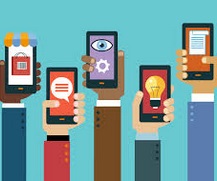 Aziz Ansari’s Modern Romance begins with an anecdote about the tyranny of texting—a tale of the agony and ecstasy associated with waiting for a response text while watching the “…” bubble turn into a fully formed message. The New York Times labels the wait between text messages as a possible cause of clinical anxiety. Seventy-nine percent of wireless subscribers in the U.S. say they text in general, according to Nielsen Mobile Insights, with U.S. smartphones users 18 and older spending 4 hours and 39 minutes on communication apps each month, according to Nielsen Electronic Mobile Measurement. So the question isn’t if you can reach someone with a mobile message. It’s when and where.
Aziz Ansari’s Modern Romance begins with an anecdote about the tyranny of texting—a tale of the agony and ecstasy associated with waiting for a response text while watching the “…” bubble turn into a fully formed message. The New York Times labels the wait between text messages as a possible cause of clinical anxiety. Seventy-nine percent of wireless subscribers in the U.S. say they text in general, according to Nielsen Mobile Insights, with U.S. smartphones users 18 and older spending 4 hours and 39 minutes on communication apps each month, according to Nielsen Electronic Mobile Measurement. So the question isn’t if you can reach someone with a mobile message. It’s when and where.
In our deep exploration of the metrics behind Drake’s Hotline Bling, we were surprised to find that dating app usage doesn’t peak as late at night as we thought it would. In fact, it peaks during primetime. But there are plenty of fish in the sea and plenty of apps to choose from, so we dove a little deeper into this evolving form of modern communication.
To start our investigation, we looked at trends across OkCupid (OKC) and Tinder, two popular dating apps that were launched eight years apart and have somewhat different approaches to online dating. For example, OKC tends to draw a morning crowd that seems to spend time checking matches and messages when they get up and right before bed. At 6 p.m. (normalized for panelists’ local time), there’s an inflection point where Tinderers start to use their app more than their OKC counterparts. 10 p.m.-11 p.m. gets the most usage time for both apps.
When we look at unique audience, we see that a larger percentage of all OKC users sign in both in the morning and night. On Tinder, the user’s likelihood to check in between noon and midnight is mostly flat at about 40%.
But what about other communication apps? Outside of the dating arena, our share-of-minute analysis found a handoff from one app to the other throughout the day. Among Facebook Messenger, Snapchat and Tinder, Facebook Messenger use is busiest of the three from morning until 2 p.m., which is when Snapchat takes over the share of minutes. When 8 p.m. strikes, Tinder hits its stride.
While time of day definitely drives peak usage for each app, our research found that more than 20% of the Facebook Messenger, Snapchat and Tinder app users check in at least once in each hour block of the day. Snapchat leads in share of users. Sixty percent or more of Snapchatters open the app at least once during most hours of the day.
There are also a few apps that blur the lines between social networking communication and messaging. Within this genre, usage across Tumblr, Twitter, Instagram and Facebook Messenger follows remarkably consistent bell curves. Only at night do the apps begin to show their colors. Facebook Messenger gives way a touch earlier than Twitter and Instagram, and Tumblr’s share of minutes doesn’t decline until a bit later into the night. From an audience perspective, Facebook’s products draw a higher share of their active users this month through the middle of the day. No matter the media, we do see people up quite late.
Email apps follow very similar trends throughout the day, with the exception of a regular spike in Microsoft Outlook minutes in the afternoon. And our frequent email activity reveals just how embedded this technology is in mobile user’s lives. The share of unique audience is higher than 20% at all hours of the night, and can climb as high as 65%. That means more than half of users check their email at least once each of those hours. For contrast, we included usage trends for Kik, a messenger whose audience skews younger than email, to highlight how app usage can mark the transition from young adult to professional life.
Now that we’ve looked into communication trends across the app landscape, knowing how to connect—and on which app—should be a little clearer. Having direct insight into which channels are most traversed and when can help communicate a message at the right place and right time. The data should provide some comfort in knowing that at almost any time of day, if there’s a will, there’s a way to reach out.


